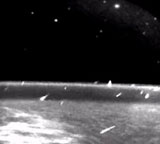Meteors
Meteors flash across the night sky as shooting stars. Most nights around 8 meteors can be seen each hour in a clear sky. At certain times of the year, however, hundreds and even thousands of meteors can be seen coming from a single point in the sky. These are called meteor showers.
Shooting stars
Most meteors you see in the sky are dust to sand-sized particles that burn up as they pass through Earth's atmosphere.
The atmosphere causes friction, which makes the particle, traveling at 11 kilometres a second, slow rapidly. This heats the particle, turning it to gas and heating the surrounding air. These hot gasses glow, producing the tail of the meteor and the appearance of a shooting star.
Meteors and meteorites
Sometimes meteors are larger fragments which don’t completely burn up in the atmosphere but fall all the way to the Earth’s surface. When these extraterrestrial rocky objects are recovered from the surface, they are known as meteorites.
Most meteors and meteorites are bits of asteroids, although some are bits of comets or, very rarely, pieces of the Moon or Mars.

1997 Leonid meteors taken from space © NASA
Meteor showers and meteor storms
At certain times of the year several hundred meteors can light up the sky in a spectacular display. These are meteor showers, and are thought to be caused by the dust ejected from comets as they pass close to the Sun.
This dust is concentrated in an orbit that follows the comet's path around the Sun. The Earth's orbit crosses these trails at regular times, causing a lot of dust to enter the atmosphere at the same time each year. This results in recurring meteor showers.
If the shower is particularly impressive it is known as a meteor storm.